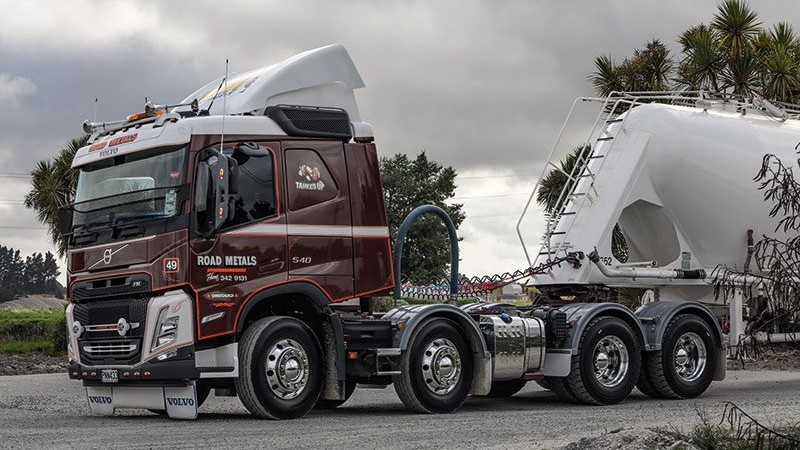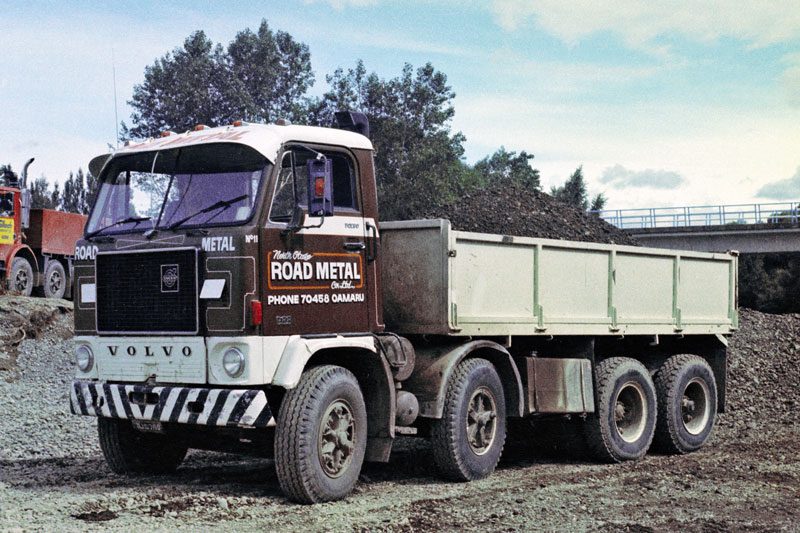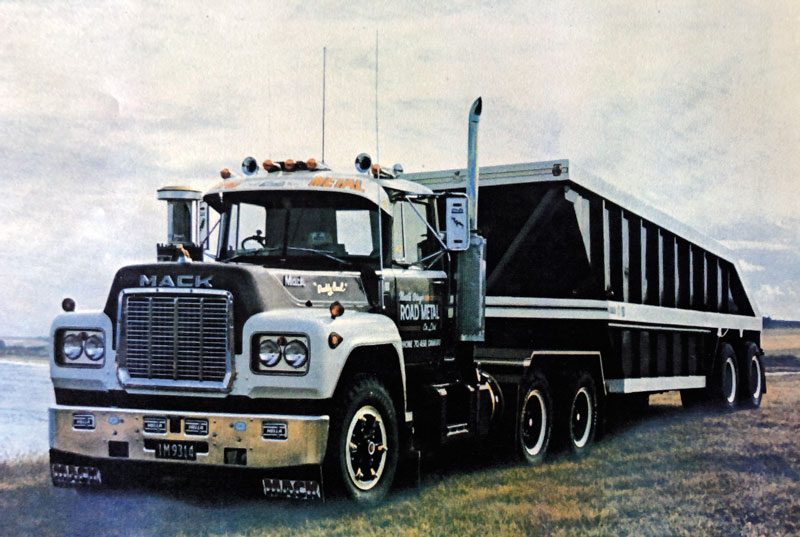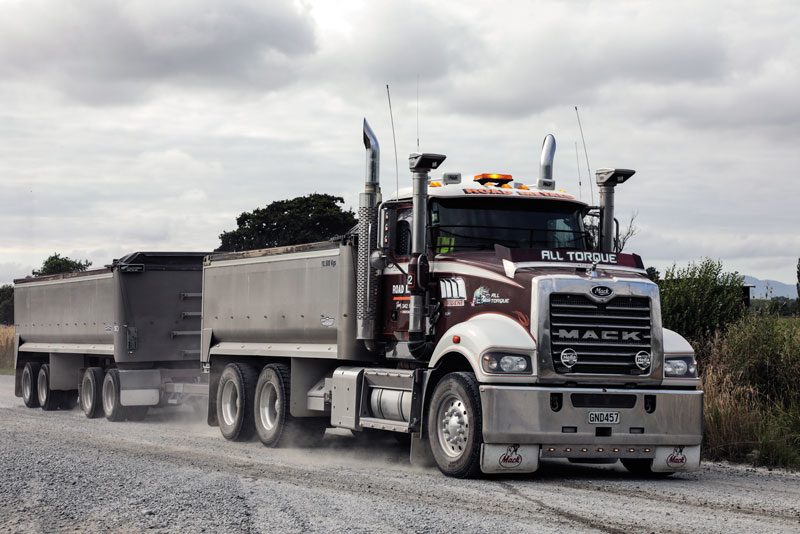
The presence of Volvos and Macks at Road Metals goes back nigh on 50 of the company’s 68 years. Commers, Thames Traders, Dodges, a sizeable Foden, and Leyland Octopuses formed the core of the transport operation before the early 1970s.
“KEW Dodges able to cart six yards (4.6m3 ) at a time,” laughs managing director Murray Francis. “Noddy trailers [simple trailers] helped increase that, almost doubling the payload.
“Dad was an innovator, always looking to cart more. I remember he brought a Foden 8×4, a huge truck in the day. In fact, he reckoned we didn’t have anyone able to drive it properly, so he employed a roadtrain driver out of Australia by the name of Dave Beattie. With its trailer, it could cart 21 yards (16.055m), and on the Otematata Saddle (SH83 between Otematata and Omarama), it would round up and pass the Dodges, grinding away in second gear with their six yards on!
“I drove most trucks, the Mack and Volvos certainly, but also time on an ERF, and before that, a Leyland Octopus – a truck I loved.”

Volvo actually beat Mack into the fleet in the form of the legendary G88 in the early 1970s. Back in those days, the brand was represented by Dalhof and King.
“The Volvos had a huge impact when they first arrived – powerful, and much like today, they were seen as very quiet and comfortable. I remember Stan offering me the first G88, and I turned it down after a trip saying, ‘It’s just like driving a car back and forwards all day!’ I wanted to drive a truck that sounded like a truck and asked for my Leyland Octopus back.”
Interestingly, before Bruce’s FM540, there’s only been one other sleeper cab Volvo in the Road Metals fleet, a G88 driven by Lindsay Forbes, a 47-year veteran who manages the Yaldhurst quarry today.
The first Macks arrived for the Twizel project in 1974. They were build Nos.54, 55, 56, and a year later, No.72.1 “They were 235hp tractors towing bottom-dump trailers on account of bottom-dumpers meeting the sales tax exemption available in the era. The semis had to be permanently fixed to the trucks with chains to prevent unhooking and use on something else.”
Round two of the Macks came in 1977, this time 285hp R686s, build 154 and then a truck that would send the company’s image viral… 1970s style. Driven by Peter McDowall, build No.155 was an R-Model Mack named ‘Daddy Cool’. Towing its bottom-dump combination, photographer Kevin Keppel immortalised the unit in one the country’s first commercially produced truck posters. North Otago Road Metals was on the bedroom wall of every truck-crazed kid in the country. The company was global in New Zealand.

“I drove that truck for a time, including the Cascade Creek roading job in the Hollyford,” says Murray. “I had a family on holiday stop me once – their son had recognised the truck and they wanted a picture. As always, I offered a ride to the young fella up to the end of the road where the stockpile was. Before I knew it, Dad was in the cab, too. It was the highlight of the holiday, evidently. Peter kept the truck immaculate, one of the most fastidious operators ever. He even pin-striped the bottom dump for that picture.
“I have to say the R-Model Mack was an incredible machine for us. That first round of trucks did 800,000km with nothing beyond regular maintenance – simple trucks without the electronic complexity of today’s machines, always fixable on the side of the road if need be. You could always get them home.”
One of Murray’s all-time favourite trucks was the MC Mack, and their arrival into the fleet is an interesting yarn.
“We had two new F cab Volvos on order but were having a stoush with Volvo at the time over a warranty rebuild on a motor that had only done 90,000km. At the same time, one of the R-Models lost a motor having done about 800,000km. Ron Carpenter raised his concern that the motor hadn’t run to the 1,000,000km he had expected and offered an engine kit if we fitted it. I remember Dad saying to him that it had done 800,000km and that’s fine, but he was insistent. That afternoon, two new Volvos became two new MC Macks.
“I drove one of the MCs and just loved it. It was like a Leyland Octopus with power. Low, with great visibility and so much power. They were 320s, and the ‘Noddy’ trailers we had at the time only had big ball couplings. The MCs pulled them apart. One’s in the museum now, and it’s not been there that long, really – just fantastic trucks.”
Road Metals has always run a two-brand policy for trucks and machines. Volvo and Mack have been the cornerstones of the modern fleet, with preference purely based on model suitability at any given time.


“For a while there, it was very Mack dominant, but then Mack brought out the Qantum, which was not a good truck, hence the rise of Volvo. Not that it matters now – they’re all in the same family, of course.
“I’ve never liked a rainbow fleet. It’s not a case of playing one off against the other – it’s just a case of the best fit for the job at the time and retaining two dominant brands allows a better understanding of where the market is at.”
Isuzu has found a niche in the Kiwi Concrete fleet alongside Mack, as has Hino, the latter also earning itself a solid reputation in the brown-and-white fleet, servicing the six-wheeler, truck-only urban tasks.
We also spied an exceptional-looking UD Quon and simple trailer making regular passes through Yaldhurst while we were there.
The number of marques that wear the brown and cream may be limited, but the tales and adventures encompassed within their cloak are endless.
Read more
A rolling stone
0 Comments6 Minutes
“Life’s too short!”
0 Comments16 Minutes
Principles in stones
0 Comments31 Minutes
Kiwi concrete home grown
0 Comments2 Minutes





